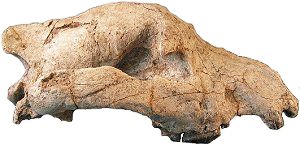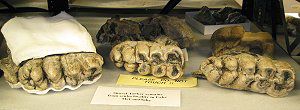
Nebraska County Fossils
Keith
< Vertebrate Paleontology Home
A virtual journey through the Museum's vertebrate paleontology collection.
Epicyon haydeni, Hayden's Top Dog
Family: Canidae
Geologic age: Late Miocene (Clarendonian), about 10.5 million years old
Year fossil collected: 1989


The genus name "Epicyon" literally means "Top Dog". Few would argue that Epicyon haydeni wasn't the Top Dog of Keith County! Compare the skull of an historic wolf from Webster County (left, top) with that of the fossil Epicyon from Keith County (left, bottom). Epicyon was a massively built predator that specialized in crunching both flesh and bone of its prey, leaving little behind for those lower down on the food chain. The site which produced this skull also contained numerous bones of other animals...most had been chewed beyond recognition.
Gomphotherium, Four-Tusked Elephant
Family: Gomphotheriidae
Geologic age: Late Miocene, about 10.5 million years old
Year fossil collected: 1988


These molars of four-tuskers were recovered by a SCUBA team from the University of Nebraska State Museum Research Divisions. The teeth were found twenty feet under the surface of Lake McConaughy where they were slowly eroding out of the bedrock. Amazingly, they were still in excellent condition after years of submersion.
Nimravides, Swift tawny cat
Family: Felidae
Geologic age: Late Miocene (Clarendonian), about 10.5 million years old
Year fossil collected: 1991


Nimravides was amoung the largest active predators of its time in Nebraska. It was actually larger than the "Top Dog" Epicyon, but less robust and with longer legs. It was built for speed and ambush, and its jaws were furnished with long canines and well developed slicing teeth for cutting flesh from its prey. At left are an upper canine tooth, an upper slicing tooth, the lower jaw, thigh bone and toe from this large cat. The scale is 25 centimeters, or nearly 10 inches, long!
Geological Ages of Rock Formations

| Q | Pleistocene ("Ice Age") Sands, gravels, silts overlay much of the county (not shown) Pleistocene sands, gravels and silts overlay much of Nebraska and often conceal the bedrock beneath. These "Ice Age" deposits often produce the remains of mammoths, bison, horses, musk oxen, elk and other familiar mammals. Small fossils, especially, are important indicators of the climate at the time of deposition. |
| Tpo | Tertiary, Miocene/Pliocene, Ogallala Group, 2-14 million years old Ogallala Group rocks include predominantly clastic sands and sandstones composed of a mixture of Rocky Mountain debris and locally derived and re-worked sediments. Ash beds are not unusual in the Ogallala and help to precisely date the sediments. In western and southwestern Nebraska, the Ogallala beds are responsible for resistant bluffs that cap the valley sides of modern streams. |
| To | Tertiary, Oligocene, White River Group, 28-40 million years old The White River Group rocks include the Chadron and Brule Formations often form large expanses of low to medium-relief badlands typical of western Nebraska (Toadstool Park) and South Dakota (Big Badlands). Siltstones and very fine sandstones dominate these units. The White River Group rocks preserve the early history of horses, rhinos and camels, all of which originated in North America. The habitats across much of the state at the time were distinctly un-Nebraskan, with low-crowned browsing mammals (forest dwellers) and their predators composing the dominant fauna. |





